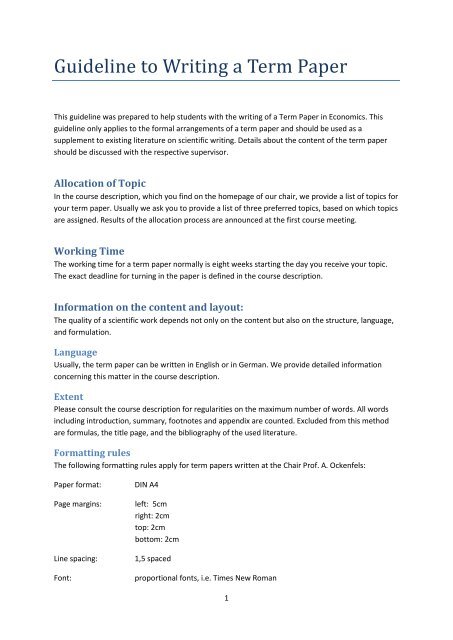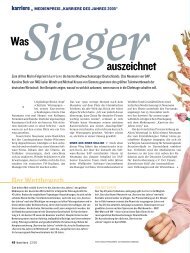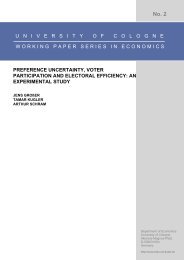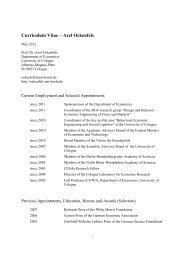Guideline to Writing a Term Paper - Lehrstuhl Prof. Axel Ockenfels ...
Guideline to Writing a Term Paper - Lehrstuhl Prof. Axel Ockenfels ...
Guideline to Writing a Term Paper - Lehrstuhl Prof. Axel Ockenfels ...
Create successful ePaper yourself
Turn your PDF publications into a flip-book with our unique Google optimized e-Paper software.
<strong>Guideline</strong> <strong>to</strong> <strong>Writing</strong> a <strong>Term</strong> <strong>Paper</strong><br />
This guideline was prepared <strong>to</strong> help students with the writing of a <strong>Term</strong> <strong>Paper</strong> in Economics. This<br />
guideline only applies <strong>to</strong> the formal arrangements of a term paper and should be used as a<br />
supplement <strong>to</strong> existing literature on scientific writing. Details about the content of the term paper<br />
should be discussed with the respective supervisor.<br />
Allocation of Topic<br />
In the course description, which you find on the homepage of our chair, we provide a list of <strong>to</strong>pics for<br />
your term paper. Usually we ask you <strong>to</strong> provide a list of three preferred <strong>to</strong>pics, based on which <strong>to</strong>pics<br />
are assigned. Results of the allocation process are announced at the first course meeting.<br />
Working Time<br />
The working time for a term paper normally is eight weeks starting the day you receive your <strong>to</strong>pic.<br />
The exact deadline for turning in the paper is defined in the course description.<br />
Information on the content and layout:<br />
The quality of a scientific work depends not only on the content but also on the structure, language,<br />
and formulation.<br />
Language<br />
Usually, the term paper can be written in English or in German. We provide detailed information<br />
concerning this matter in the course description.<br />
Extent<br />
Please consult the course description for regularities on the maximum number of words. All words<br />
including introduction, summary, footnotes and appendix are counted. Excluded from this method<br />
are formulas, the title page, and the bibliography of the used literature.<br />
Formatting rules<br />
The following formatting rules apply for term papers written at the Chair <strong>Prof</strong>. A. <strong>Ockenfels</strong>:<br />
<strong>Paper</strong> format: DIN A4<br />
Page margins: left: 5cm<br />
right: 2cm<br />
<strong>to</strong>p: 2cm<br />
bot<strong>to</strong>m: 2cm<br />
Line spacing: 1,5 spaced<br />
Font: proportional fonts, i.e. Times New Roman<br />
1
Font size: 12 for standard-text blocks<br />
Paragraphs: can be displayed left aligned or justified. If you choose justified, please<br />
activate the syllabication function.<br />
Only one side of the paper is printed on. The titles are highlighted in different font sizes<br />
corresponding <strong>to</strong> their importance.<br />
The term paper does not have <strong>to</strong> be submitted as a hardback copy. It is sufficient <strong>to</strong> hand in one copy<br />
of the paper in a folder. Additionally, we require an electronic version of the paper and the literature<br />
used. Please hand in these documents preferably saved as PDF-files or Word-documents on CD/DVD<br />
with your paper.<br />
Arrangement of the pages:<br />
1. Title page<br />
2. Table of Content<br />
3. List of Figures and List of Tables (if necessary)<br />
4. List of Abbreviations (if necessary)<br />
5. Main text<br />
6. Bibliography of the used literature (in alphabetical order of the authors)<br />
7. Appendix (if necessary)<br />
8. Declaration (see below).<br />
Title page<br />
There are no specific requirements for the title page of the term paper. It would be appropriate, if it<br />
could correspond <strong>to</strong> the sample of the Examination office existing for Diploma, Master’s and<br />
Bachelor theses.<br />
Lists of Figures and List of Tables<br />
Figures and tables must be labelled according <strong>to</strong> the content of the image or chart (time, locale,<br />
dimension, etc.). Geographical images, charts, curves, marks, etc. have <strong>to</strong> be labelled. The charts and<br />
images should be numbered in ascending order throughout the entire text. If a large number of<br />
figures or tables have been used, one is advised <strong>to</strong> put them all in the appendix. When referring <strong>to</strong><br />
one of the figures or tables, the number of the respective figure or table has <strong>to</strong> be mentioned in the<br />
text. The source of the figure or table should possibly be placed below. When creating a new figure<br />
or table based on figures and tables provided by other authors, all used documents have <strong>to</strong> be listed.<br />
A list of figures and tables has <strong>to</strong> be included before the text.<br />
List of Abbreviations<br />
The list of abbreviations should not contain common abbreviations such as “e.g.”.<br />
Structure<br />
One can choose between a numerical order and an alphanumerical order. Each number should be<br />
followed by a period. Subsections are allowed if there is more than one subsection. For example, if<br />
there is a subsection called 1.1, a subsection called 1.2 should exist.<br />
Headings should not stand alone without text <strong>to</strong> avoid subsequent headlines stringing <strong>to</strong>gether. In<br />
this case, one may, for example, describe briefly the structure of the following subchapters.<br />
2
It is recommended <strong>to</strong> present an introducing section before the main text <strong>to</strong> inform the reader about<br />
the content of the thesis, the central problems and the methodical procedure.<br />
The final section of the thesis should summarize the main findings and conclude.<br />
The following points have <strong>to</strong> be noted regarding the table of content:<br />
Although the table of content is simply an aid for the readers and evalua<strong>to</strong>rs, it also shows the<br />
writer’s understanding of the problem and her ability <strong>to</strong> cope with a task in a structured and accurate<br />
manner.<br />
The table of content allows the reader <strong>to</strong> follow the author’s thought process and recognize the<br />
weighting of each <strong>to</strong>pic. The Table of content has <strong>to</strong> be structured logically and from general <strong>to</strong><br />
specific. A large number of sub<strong>to</strong>pics often indicate that the choice of main <strong>to</strong>pics is not perfect.<br />
The table of content should not be <strong>to</strong>o detailed. The length of each part should be approximately<br />
equal and each text should not be further subdivided.<br />
Main Text<br />
The writer should avoid an inappropriate diction, imprecise terms and undifferentiated judgments<br />
like “should”, “must” or “fulfill”. Own judgments must be differentiated <strong>to</strong> statements of facts.<br />
Quotations<br />
Quotations standardize the main formalities and should be structured in line with the appropriate<br />
literature. It is recommended <strong>to</strong> use the Harvard citation style, thus marking quotations within the<br />
text by stating the author’s name, the year of publication, and the relevant pages in parentheses<br />
instead of using footnotes - for instance (Müller 2004, p. 37).<br />
Direct quotes must be marked as such by quotation marks followed by the author’s name, the year<br />
of publication, and the relevant pages in parentheses as shown here: „Direct quote“ (Waringer and<br />
Schulz 2003, p. 10).<br />
Small letters should be used <strong>to</strong> differentiate between works by the same author published in the<br />
same year: (Müller 2002a, p. 37) or (Müller 2002b, p. 68).<br />
Multiple authors should be separated by a comma: (Meyer, Schulz, and Mosblech 2003, p. 10)<br />
Multiple sources should be separated by a semicolon: (Waringer and Schulz 2003, p. 23; Theisen<br />
2003, p. 137)<br />
If you use the authors’ name within the sentence, just use the year of publication in parentheses.<br />
Example: “Research by Waringer and Schulz (2003) supports ...”<br />
Quotations in foreign languages should be avoided in the main text. Instead the writer of the thesis<br />
should present an appropriate translation of the relevant part of the quotation. Please note that<br />
quotations in English pose an exception <strong>to</strong> this rule.<br />
Translations conducted by the author of the thesis should be labelled as such at the end of the<br />
relevant section.<br />
3
If you write your thesis in English, passages from German publications can be cited literally using<br />
quotation marks and vice versa. Indirect citations should be marked as such.<br />
In case of quoting symbols from different sources (e.g. in formulas), these should either be explicitly<br />
defined or exchanged with those previously used in one’s thesis.<br />
For quotations from sources published only online, please note the following: One should state the<br />
name of the author, the year of publication and the date of the download. The URL should be listed<br />
in the bibliography.<br />
A printed version of the online source should be presented on request.<br />
References and Bibliography<br />
The Bibliography gives a list of the literature used by the author and gives credit for the use of<br />
concepts from other authors. It is also possible, that readers are introduced <strong>to</strong> unknown literature.<br />
The bibliographic information has <strong>to</strong> be complete and accurate <strong>to</strong> ensure accessibility of the source<br />
for verification.<br />
It is not recommended <strong>to</strong> use many references with a large amount of literature just <strong>to</strong> make a good<br />
impression. Bear in mind that each piece of literature raises the standard against which your term<br />
paper is measured.<br />
The bibliography should only contain literature that has been referred <strong>to</strong> in the footnotes. The<br />
literature should be sorted by authors in an alphabetical order. If an article is part of a book, which<br />
includes a collection of articles, one should give the author of the article and its title first and then<br />
provide details about the book’s authors, title, and publication details.<br />
Each item in the bibliography list should include the following information:<br />
The name and surname of the author(s) (in case of an anonymous author use “N.N”), the tile of the<br />
article (if the article is a chapter in a book with a collection of articles, provide the name(s) of the<br />
author(s) of the book with an “ed(s).” in parenthesis after their names),<br />
the volume, the edition (where applicable),<br />
the location of publication (in case of multiple mentioning the first is sufficient),<br />
the number and the year of the magazine the article was published in (where applicable),<br />
the year of publication, and the range of pages in the magazine or the respective chapter in the book,<br />
Internet: name, date, URL, and the time of the download or the time of the page visit.<br />
Dealing with two or more authors the following scheme should be applied putting names and first<br />
names in order: LastName(A), FirstName(A), FirstName(B) LastName(B) and FirstName(C)<br />
LastName(C).<br />
However, all other details should be listed as mentioned previously.<br />
4
Examples:<br />
Bol<strong>to</strong>n, Gary E. and <strong>Axel</strong> <strong>Ockenfels</strong> (2000): ERC – A Theory of Equity, Reciprocity and Competition,<br />
in: American Economic Review, 90(1), p. 166-93.<br />
International Energy Agency (ed.) (2005): Energy Prices and Taxes, Third Quarter 2004, Paris 2005.<br />
De Vries, Casper, Alireza Namazi, <strong>Axel</strong> <strong>Ockenfels</strong> and Andreas Schadschneider (2007): The<br />
Economic and Statistical Laws of Bid Timing and Bid Amounts in Online-Auctions, Working <strong>Paper</strong>,<br />
University of Cologne.<br />
Doe, John (2010): www.johndoe.co.uk/publications/test.pdf, 19.03.2010.<br />
Declaration<br />
The following signed declaration of originality has <strong>to</strong> be submitted in German <strong>to</strong>gether with the date<br />
of term paper.<br />
„Hiermit erkläre ich, dass ich die vorliegende Arbeit selbständig und ohne Benutzung anderer als der<br />
angegebenen Hilfsmittel angefertigt habe. Alle Stellen, die wörtlich oder sinngemäß aus<br />
veröffentlichten und nicht veröffentlichten Schriften entnommen wurden, sind als solche kenntlich<br />
gemacht.“<br />
Translation:<br />
„I hereby declare that I have single-handedly written this term paper and used only allowed<br />
resources. All passages containing published or unpublished work by other authors are marked as<br />
such. “<br />
General comments<br />
The first principle during the compilation of a term paper is:<br />
Every statement has <strong>to</strong> be comprehensible. This is fundamental for every scientific paper. The writer<br />
has <strong>to</strong> specify if a text passage contains own research findings, own views or the views of other<br />
authors. The formulation of the view of other authors can be made literal (through quotation) or<br />
through using the conjunctive.<br />
If the term paper refers <strong>to</strong> sources that are not generally available, the writer has <strong>to</strong> make these<br />
sources available in case they are needed during the evaluation of the paper.<br />
Each term paper has <strong>to</strong> contain a summary in the final section. Partial results are listed in each<br />
subsection as a summary, if possible.<br />
Valuation principles<br />
Every term paper covers a different <strong>to</strong>pic and thus has its individual structure and approach. This<br />
makes comparison of different theses impossible. Hence, no standard evaluation criteria exist.<br />
Nonetheless, the following aspects of the paper are usually taken in<strong>to</strong> account in the process of<br />
evaluation:<br />
5
1. Topic of the thesis:<br />
The objective difficulty of the <strong>to</strong>pic<br />
Amount of work required<br />
The importance and the formulation of the <strong>to</strong>pic<br />
Level of independent contribution<br />
2. Content of the thesis<br />
Systematic problem-solving methods<br />
Weighting of each <strong>to</strong>pic<br />
The result of the audi<strong>to</strong>rs’ personal contribution<br />
Approached and concepts applied<br />
3. Formal arrangements<br />
Structure and subdivision<br />
Scientific language<br />
Accuracy of figures and tables<br />
Quotations and spelling<br />
Further readings<br />
The following books provide useful tips about writing term papers in a scientific context:<br />
Cole, Arthur H. and Karl W. Bigelow, (2006): A Manual of Thesis-<strong>Writing</strong>: For Graduates and<br />
Undergraduates, 1 st edition, Cosmo Study Guide.<br />
Clark, Irene L. (2006): <strong>Writing</strong> the Successful Thesis and Dissertation: Entering the Conversation, 1 st<br />
edition, Pretince Hall International.<br />
Zerubavel, Eviatar (1999): The Clockwork Muse: A Practical Guide <strong>to</strong> <strong>Writing</strong> Theses, Dissertations,<br />
and Books, Harvard University Press.<br />
6






